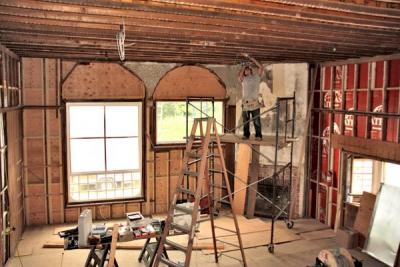Moran House Reconstruction Makes Haste Slowly

It is over a year since The Star last reported on progress at the Thomas Moran house, the national historic landmark opposite Town Pond in East Hampton that is being restored, pillar by post, month by unhurried month, to its former somewhat unorthodox glory.
A great deal of progress has been made inside the 1885 building, which visitors to Main Street aren’t able to see, though so much work still remains, both inside and out, that to say the undertaking is even one-third finished would probably be stretching it.
One of the most crucial challenges of the entire operation — getting the front of the wobbly structure shored up before another Sandy could take a crack at it — was met during the fall. That enabled the structural phase of the project to get under way, starting with a new foundation. Along with the floors and walls, it has now been leveled and reinforced.
Most recently, workers installed a sprinkler system — “a very big deal,” said Robert Hefner, East Hampton Village’s director of historic services, who heads the restoration team along with Richard Barons, executive director of the East Hampton Historical Society and the Thomas Moran Trust. “They had to drill through a lot of floor joists to run the pipes through,” Mr. Hefner explained. Infrastructure for air-conditioning is also now in place, along with ducts for heating, all of which was put in over the past few weeks with “everybody working together.”
Moran assembled his house higgledy-piggledy, adding features here and there as the years passed. It was not electrified until 1900. The original wall switches are still in place and will stay there, Mr. Hefner said, as unmistakable artifacts. So will some exposed plumbing.
Though renowned as a painter of the American West, Moran lived on and off in East Hampton for about 35 years and did much of his work here in the vast front room. A major feature of the Studio, as the house was and still is known, was the oversized window positioned on the room’s north wall, affording requisite north light. The artist, whose custom it was to wander the streets of his Manhattan neighborhood looking for buildings being demolished and make off with whatever struck his fancy, is believed to have taken the big window, and a smaller one to the side, from a commercial building at Broadway and 22nd Street, where he also appropriated his front doors.
The large window had been used for display, with a cross-hatched transom above it. Moran reversed their position, putting the window above and the transom below, a decision that caused some grief for the restorers. “The transom wasn’t built to be underneath, it was built to shed water,” Mr. Hefner said. “So there was a lot of rot from water damage.”
The two windows were removed from the house last summer before it was raised and stabilized. Three weeks ago the window frames returned, as good as old and better, thanks to the craftsmen Adam Galecki and Jim Field. “A lot of repair was needed,” Mr. Hefner said. Mr. Galecki patched, Mr. Field glazed and painted.
The upside-down transom is back on the wall, still upside down. All that is missing there now is a new six-by-six piece of glass and two leaded-glass fanlights, not yet back from restoration in Eastport, at the windows’ top.
The otherwise smooth progress had one unexpected hiccup recently. The house’s exterior trim, of Atlantic white cedar, which was being milled in Rhode Island, was lost in May in a fire there, and has not been easily replaceable. “It’s a great wood, but not so easy to get,” Mr. Hefner said.
Shingling, which is coming from a mill in faraway British Columbia, has been delayed until the new trim is ready. The plan now is to have the front of the house shingled by late summer or early fall, at which time, Mr. Barons said, the Moran Trust, which has an ongoing campaign to pay for the work and provide an endowment, is planning a big fund-raiser.
